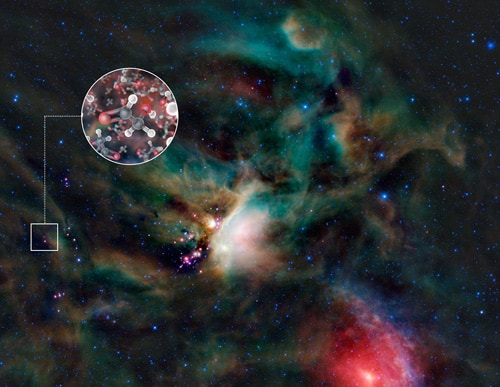
(Courtesy: ALMA (ESO/NAOJ/NRAO)/L Calçada (ESO) and NASA/JPL-Caltech/WISE Team)
By Tushna Commissariat
A team of astronomers in Denmark has spotted sugar molecules in the gas surrounding a young Sun-like star. And why is finding sugar in the gas surrounding a star important, you ask? It’s important because it tells us that complex organic molecules, like the sugars, that form the building blocks of life can be found around young stars at the time when planets could be begin to form around them.
The team found molecules of one of the simplest form of sugar – glycolaldehyde – in the gas surrounding a young binary star known as IRAS 16293-2422, which has a mass similar to that of the Sun. While the sugar has been found in space before – within our galaxy itself – this is the first time it has been found in close proximity to a star; in fact, it’s as close to IRAS 16293-2422 as Uranus is to the Sun. This discovery shows that some of the chemical compounds needed for life existed in this system at the time of planet formation. IRAS 16293-2422 is also located only about 400 light-years away from us – a mere hop, skip and jump in astronomical terms, making it an excellent target for astronomers studying the molecules and chemistry around young stars.
“In the disc of gas and dust surrounding this newly formed star, we found glycolaldehyde, which is a simple form of sugar, not much different to the sugar we put in coffee,” explains Jes Jorgensen from the Niels Bohr Institute in Denmark, who was the lead researcher of the team that used the Atacama Large Millimeter/submillimeter Array (ALMA) to observe the star. “This molecule is one of the ingredients in the formation of RNA, which – like DNA, to which it is related – is one of the building blocks of life.”
The image above shows the Rho Ophiuchi star-forming region in the infrared, as seen by NASA’s Wide-field Infrared Explorer (WISE). IRAS 16293-2422 is the red object in the centre of the small square. The inset image is an artist’s impression of glycolaldehyde molecules, showing glycolaldehyde’s molecular structure (C2H4O2).
“What it is really exciting about our findings is that the ALMA observations reveal that the sugar molecules are falling in towards one of the stars of the system,” says team member Cécile Favre of Aarhus University in Denmark. “The sugar molecules are not only in the right place to find their way onto a planet, but they are also going in the right direction.”
Jorgensen further explains that the gas and dust in clouds surrounding newly formed stars is initially extremely cold (only around 10 degrees above absolute zero at –273 °C) and simple gases such as carbon monoxide and methane settle on particles of dust and solidify as ice, and only after this occurs are more complex molecules formed. The newly formed star then heats its neighbourhood, evaporating the complex molecules from the dust and gas, and these molecules are then detected as radio emissions at low frequencies by telescopes such as ALMA.
“A big question is how complex can these molecules become before they are incorporated into new planets? This could tell us something about how life might arise elsewhere, and the ALMA observations are going to be vital to unravel this mystery,” concludes Jorgensen.



